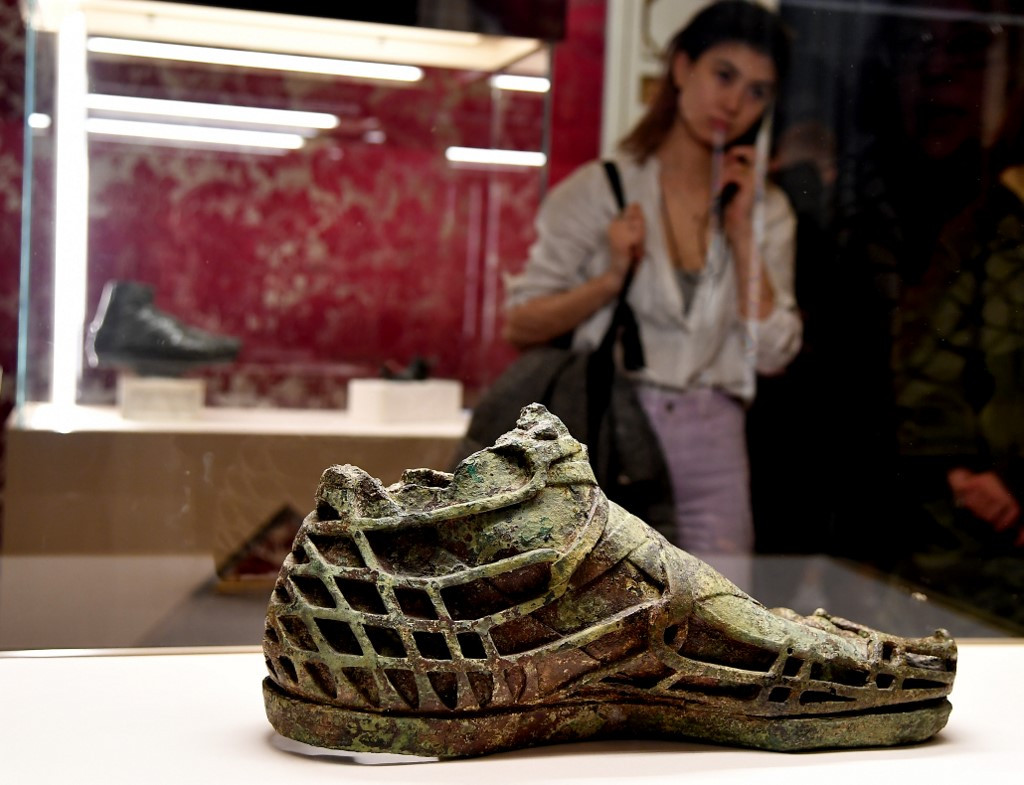Popular Reads
Top Results
Can't find what you're looking for?
View all search resultsPopular Reads
Top Results
Can't find what you're looking for?
View all search resultsShoes fit for the Gods go on display at Italy's Pitti Palace
Change text size
Gift Premium Articles
to Anyone
A
s sandal season fast approaches, a new exhibit on ancient footwear at a top Italian museum seeks to remind today's well-heeled that when it comes to fashion, do as the Romans did.
The classics are always in, as evidenced by the new show in Florence's Pitti Palace, which traces the humble sandal's outsized influence in contemporary fashion and film, while astonishing the modern eye by the elegance of the ancients.
"At the Feet of the Gods: The art of footwear in ancient Rome, epic film and contemporary fashion," features 80 works from sculptures and decorative urns to sandals ancient and new, many on loan from international museums.
The show -- which promises to satisfy the curiosity of both shoe fetishists and wearers of plastic Crocs alike -- runs through April 19.
"With this show, we've tried to make the shoe, commonly thought of as an accessory, instead the protagonist," Fabrizio Paolucci, one of the curators, told AFP.
In ancient times, shoes acted as a sort of "identity card" for their owner.
They could reveal a great deal of information about the wearer -- such as their sex, profession or economic status -- even more so than today, when the choice of a pair of red-bottomed Christian Louboutin stilettos, Nike swooshes or orthopaedic (but now trendy) Birkenstocks is loaded with meaning.
The humble sandal, whose prehistoric forerunners date as far back as 10,000 years, flourished under the ancient Greeks, whose deities were their best models.
Massive feet in marble and bronze, the remnants of destroyed statues of gods and others, are brought together in the show, all adorned with "krepides" -- sandals fastened via an intricate web of laces covering the foot.
The delicate footwear is also seen on pottery dating back as far as the fifth century BC.
On one vase, Eros, the Greek god of love, helps a virgin change into the skin-exposing sandals she will wear as a bride.
On an Etruscan urn, a nude courtesan laces up sandals whose nailed soles left impressions on carpets spelling, "Follow me".
Read also: Beat them with the ugly chic
Sandals with socks?
Greek footwear paved the way centuries later for the "caliga" worn by Roman soldiers, authentic examples of which can be seen in the show, their leather still intact.
The low sandals with exposed toes, reinforced by iron studs hammered into the soles and sometimes worn with socks, were ideal footwear for Roman armies, who often marched as far as 35 kilometers per day.
They were also the ideal inspiration for Hollywood costume designers tasked with outfitting thousands of extras in the "sword-and-sandals" movies of the 1950s and beyond, from Ben Hur in 1959 and Cleopatra in 1963 to Gladiator in 2000.
The exhibition places side by side ancient objects with footwear from these films, including the brown and gold boots worn by Charlton Heston in Ben Hur -- a sort of ancient Roman Doc Martin -- or Elizabeth Taylor's towering gold platforms in Cleopatra.
"Footwear in film offers some very accurate comparisons based on detailed study of how the shoes were created," said Lorenza Camin, another of the show's curators. "Others are more imprecise."
One case in point is the 2004 film Alexander starring Colin Farrell about the Greek general of the same name -- in which the actors nevertheless sport Roman footwear.
Read also: Christian Louboutin exhibition opening in Paris in 2020
Gladiators with hairy feet
Set in the sumptuous rooms of the ornate palace, the exhibition's more modern takes on ancient footwear would cause Imelda Marcos to swoon.
Few would be reminded of hairy-toed gladiators when gazing on the delicately criss-crossed gold ankle boots from Italian brand Genny in 1994 or Emilio Pucci's thigh-high stiletto sandals constructed of 26 bands of leather -- perfect for a Roman dominatrix.
Roman-inspired creations by Yves Saint Laurent, Ferragamo and Richard Tyler all appear, and to end the show, a ruby red Rene Caovilla sandal with a snake-like strap embossed with Swarovski crystals slithers up an imaginary ankle.
And in case of sore feet, the show also boasts a second-century therapeutic foot warmer in which warm liquid would have been poured into a cavity covering a ceramic foot form.
Gladiators, soldiers -- and wearers of modern-day stilettos -- would be grateful.











